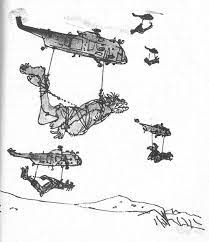
“Keep cool, Simpson. Be in the game, but not of the game.” – Bart Simpson
Calculator
What does it mean to be intelligent?
Douglas Hofstaeder has an interesting idea: intelligence can escape its own nature.
A calculator has astonishing information-processing power, but it’s not intelligent. It can perform six digit division instantly, but it will never not be a calculator. It reigns as king of a tiny kingdom, a beached whale in six inches of water, unable to escape or even understand its limits. It just calculates blindly, firing shafts of voltage across an integrated circuit’s OR, AND, NOT, and XOR gates, doing what it’s always done and getting what it’s always gotten.
It’s incapable of reasoning. It can’t think “the plus key has been continuously pressed for an hour, which seems like a mistake or a jammed key, so I’ll ignore additional input to that button.” Nor can it think “my operator has entered the numbers 2, 4, and 6, so I’ll preload the numbers 8, 10, and 12 into memory just in case.”
Note that these are things would help it calculate. Bizarrely, a calculator is so thoroughly a calculator that it’s actually…an imperfect calculator. The greatest calculator wouldn’t be a calculator, it would be a meta-level device that transcends a calculator’s limits.
I think the same is true for us. I assert that the highest peaks of the human experience (whatever you mean by that) are only accessible to non-human lifeforms.
Feeling love? Human love is tainted by transactional self-interest and chemicals. Introspection? I can barely do it: my brain can only hold about seven items in short term memory at once. Enjoying art? I’ve never experienced a work of art in my life – my eyes only see a narrow 400mn band of electromagnetic energy, my ears only hear wavelengths in the 20hz-20khz range, and if I expose myself to too much light and sound, I become blind or deaf. Even the experience of “qualia”, such as a subjective perception that red is the “hot” color, is obviously influenced by facts about the world, such as the fact that fire is red. I will never get a glimpse of 99.99% of the universe. I’m living in a cell and the cell is me.
But imagine Human 2: an unlimited human. It loves boundlessly, introspects depthlessly, and its senses pour like oceans over every cognitive horizon imaginable. Human 2’s “music” might be the distant decaying rumbles of the Big Bang. It might admire the flickering of gamma rays from a single atom the way we admire the northern lights. It wouldn’t be cold or mechanical, but the opposite: alive at a transcendental level. It would view us the way we view robots, crude behavioral engines responding to gross stimuli. Why am I calling it “it”? I’m the it.
You might not consider Human 2 to be a human at all, might argue that these limitations are part of what make us human. I don’t accept this, and we don’t seem to apply this logic anywhere else: nobody thinks cripples are more human than able-bodied people, or that blind people are more human than sighted people, or that Albert Einstein was less human than those around him. In fact, creativity (which is a fancy way of ignoring mental ruts) is thought of as a particularly human trait. But even if Human 2 is nonhuman, such a being would at the very least be very, very powerful.
It’s quite a talent to be wrapped in chains, think “no”, and watch them all melt away.
Nakatomi

One of the more thought-provoking things I’ve read is Nakatomi Space.
In short? The action movie Die Hard contains hidden depths (in more senses than one), and Bruce Willis’s character John McClane might be among the more intelligent characters in fiction. I won’t repeat the plot, which isn’t a story so much as a situation: McClane is trapped in a building, unarmed and alone, and a team of gunmen are attempting to kill him. This is a bad reality for McClane, and he survives by ignoring that reality and substituting a better one.
He navigates Nakatomi Plaza by bizarre means. He climbs through ducts, descends elevator shafts, breaks through walls, and scales the outside of the building. Watch the film, and you’ll hardly see a single instance of him moving through the building in the way the architect intended.
Hans Gruber’s men are watching hallways and stairwells, and they’re completely caught off-guard by McClane’s unorthodox traversals of Nakatomi Plaza. He is an archetypical “everyman” and has no powers, yet in a sense they are Human 1 and he is Human 2. He’s able to outwit them because he’s not limited by their mental conceptions of what’s possible. Gruber’s thugs are like calculators. In a fair fight, they would crush McClane, just as we’d be crushed if we tried to outcalculate a Ti-86. But they never get a fair fight, because they’re slaves to the reality around them, while McClane has picked the lock.
It comes back to the question: who defines space? Who decides what’s a wall and what’s not? Who decides where you can walk and where you can’t?
Most office walls are literally just air: thin sheets of drywall, fluffy insulation, and a couple of wooden studs. A man with an X-Acto knife can cut through them in seconds. Why shouldn’t you do that, if you need to? Because an architect didn’t plan for you to move through his building that way? What did that architect ever do for you? Likewise, air ducts and elevator shafts can allow for movement of things other than air and elevators. This isn’t intended design though, and most people can’t think forward to the next step: unintended design. McClane can, though. So can some soldiers in the real world.
In the above article you’ll find a link to an essay called “Lethal Theory”, by Israeli architect Eyal Weizman. He discusses Israeli combat practices during the Battle of Nablus, where they used a McClanelike approach to urban warfare. They would conduct combat operations in straight lines on a map, ignoring barriers in the way. If they encountered a wall, they tore it down or blasted a hole in it. If there was a house in the way, tough shit. This completely bypassed the difficulties of urban combat (choke points, sniper nests, free-fire zones), simply by redefining obstacles out of existence. They tunneled through the city, coring it as a worm eats an apple. Cities, like individual walls, are just collections of atoms in the end. All that matters is how easily you can move those atoms. There’s really no reason to retain a mental conception like “wall” when you have tanks and high explosives.
They were inspired by the work of Deleuze and Guattari (see this piece on smooth and striated space), in a rare case of post-structuralist philosophy being useful for something.
Furthermore, soldiers used none of the streets, roads, alleys, or courtyards that constitute the syntax of the city, and none of the external doors, internal stairwells, and windows that constitute the order of buildings, but rather moved horizontally through party walls, and vertically through holes blasted in ceilings and floors.
[…]
“There is no other way of moving! If until now you were used to moving along roads and sidewalks, forget it! From now on we all walk through walls!”
In the words of IDF paratrooper brigade commander Aviv Kokhavi:
We decided … to simply look at the space architecturally different… This space that you look at, this room that you look at, is nothing but your interpretation of it. Now, you can stretch the boundaries of your interpretation, but not in an unlimited fashion. After all it must be bound by physics – it contains buildings and alleys. The question is: how do you interpret the alley? Do you interpret the alley as a place, like every architect and every town planner does, to walk through, or do you interpret the alley as a place forbidden to walk through?
I’m reminded of a story told by Otto Carius, a WW2 German tank ace. He was dueling in a Jagdtiger against an enemy tank, which took shelter from his superior firepower behind a building. But Otto knew that his 128-millimeter Pak 44 main gun had awesome penetration. He guessed at the tank’s position, pulled the trigger, and turned the enemy tank into slag behind two walls. The mental shorthand of “Walls keep me safe”, ironically, can kill you.
If you have the power to ignore creative limits, you have a rare gift. I can’t really do it, personally. It’s easy enough to design something. It’s harder to undesign something, to unsee an old pattern and replace it with a new one.
Part of being a hacker is attaining this kind of second sight. Whether we’re talking about code or systems design, , seeing weaknesses that are invisible. After all, visible weaknesses are by definition out in the open, and would have been attacked (and reinforced against) already. The road nobody travels is often the easiest. Likewise, part of security involves awareness that apparently solid walls can suddenly melt away, if an attacker is clever enough.
Dissolve

In the 21th century, we understand something about limits, chiefly because humanity is pressed face-first against them.
Science is slowing down. Human intellectual achievement is reaching the crest of a sigmoid function – we’re working harder to gain less and less knowledge. Right now, 90% of the scientists who have ever existed are alive, and we are making alarmingly little progress on the deep questions of reality. Does dark matter exist? How to unite quantum physics and the general theory of relativity? How does the Higgs boson interact with particles of different mass? Where does life come from? Many Worlds vs Copenhagen vs something else? Whither consciousness? How does etc?
We have painstakingly drawn up a sketchy and incomplete map, with coastlines that don’t connect, and contradictory reports from different explorers. From time to time, scientific upheaval causes great swathes of our map to flash up in flame, erasing knowledge we thought we had.
…and looming above all, a meta-question: what are the questions we’re not even seeing? What intellectual issues are invisible to us because of our nature as humans, just as a calculator can’t draw inferences from a button being pressed for eight hours continuously?
The idea that we’re blocked is profound. After all, if you’re blocked, you might someday be free. For centuries, thinkers have thrown themselves at the walls of their humanity, using drugs, religious experiences, and deprivation to try and crack those walls and let in light. Most of them fail, and the walls actually harden from stone to steel as the years pass. And the few people who succeed (Artaud, Bowie, Turing) often end up dead or mentally scarred.
It’s not surprising that our attempts to break free have failed. Evolution has spent years rolling dice with our brains. Any obvious change our neural architecture that boosts our intelligence or our creativity should have been uncovered by chance by now.
All that remains is an engineered solution. It’s possible that one exists, right around the corner. The fact that we can’t even see the faintest glimpse of one isn’t cause for despair. A person can guess a computer password for eternity – that doesn’t mean the password’s unsolvable, or even difficult. Someone else might know that the password setter was a Wu Tang fan, enter “cashruleseverythingaroundme” and get inside on their first try. That’s the hope for humanity. That the all-surpassing limits locking in the human mind are actually easily subvertible, if you know how. Limits are funny, like one-way glass. From the inside you see impassable barriers. People on the other side forget they even exist. One day, we will build those who walk through walls, and they might be us.
“For the foolishness of God is wiser than men; and the weakness of God is stronger than men.” – 1 Corinthians 1:25

Imagine waking up, and you’re not alone. There’s a thing with you, very close. You can’t see it or touch it. It’s in your head.
With dawning horror, you become conscious of the pulsating wormlike mass twisted right through the center of your brain. It’s infesting you like a cordyceps parasiting a spider – running man-in-the-middle attacks on all your senses and limbic network. It’s intimately a part of you. You sense intelligence, and malevolence, and tension, as though its a coiled spring, ready to discharge kinetic energy.
What are you? You ask the presence, although there is no answer. Just snuffling breath, hot and excited.
You go about your day with this alien thing inside you, itching like a tangled pile of wet hair. At the day’s end, the mass seems heavier, denser, more substantial. You are incubating it. You’re a shell. It’s larvae.
The parasite doesn’t affect your behavior, but you are nevertheless worried. What does it want? Why won’t it talk? It’s just there: staring at the world through your eyes, as if seeking some sign, some augury. It knows its time will soon come.
It’s waiting.
* * *
In 1969, German artist Sigmar Polke (13 February 1941 – 10 June 2010) produced a painting titled Higher beings commanded: paint the top right corner black!

The impact of black on white is cataclysmic. The light and dark collide with ringing force. While the piece applies some schoolbook ideas about art (notably the rule of thirds), it appears unsettled and unbalanced, with the black and black basically at war. The white could be an icecube, losing itself to heat and chaos (I’m reminded of how icecubes always melt at a slant, even on a flat surface) Or maybe it’s the reverse: the black is a body of water freezing solid, losing ground to ice, becoming imprisoned in covalent bonds.
The text underneath reads like an excuse. I’m not responsible for this disaster. I was just following orders. This is the infamous Nuremberg defense, so-called because it’s what the Nazi death camp guards said at their trials.
Sigmar Polke was an interesting and diverse artist, who worked in and incorporated stylistic influence from many schools and traditions. He painted with arsenic, meteor dust, smoke, uranium rays, lavender, cinnabar and a purple pigment from the mucous excreted by snails. Higher beings commanded: paint the top right corner black! is actually part of a sequence of similar paintings, including geometric shapes, birds, and more. Many of them are striking works. All were commanded into existence by mysterious “higher beings”, and all share the same exculpatory denial: It is not me.
What were these higher beings?
That’s the thing: there weren’t any. Artists often describe their creative impulses as something external – a muse, or an inspiration – and sometimes they almost attribute conscious agency to these things. They’re like possessing demons.
But in reality, everything an artist does comes from the artist (minus aleatory methods like those of the Oulipo school, or the Oblique Strategies, use of which is itself a choice). There aren’t any outside forces controlling: or, if they are, they interact with your brain in a way that’s distinctly personal to you.
JK Rowling claims that the character of Harry Potter just fell into her head. It may have felt that way to her, but it’s not true. Harry Potter didn’t fall from anywhere. He was invented by JK Rowling. If she hadn’t existed, Harry Potter wouldn’t have fallen into another woman’s head. He would have never existed at all. She is his mother.
Sometimes, this comes off as a way of ducking responsibility. If the artwork is successful, the artist takes full credit. If not…well, the muse wasn’t speaking that day.
Non-artists play this game, too. The 20th century Indian mathematical prodigy Srinivasa Ramanujan was given to crediting his insights to dreams and visions.
The mathematical genius made substantial contributions to analytical theory of numbers, elliptical functions, continued fractions, and infinite series, and proved more than 3,000 mathematical theorems in his lifetime. Ramanujan stated that the insight for his work came to him in his dreams on many occasions.
Ramanujan said that, throughout his life, he repeatedly dreamed of a Hindu goddess known as Namakkal. She presented him with complex mathematical formulas over and over, which he could then test and verify upon waking. Once such example was the infinite series for Pi:
Describing one of his many insightful math dreams, Ramanujan said:
“While asleep I had an unusual experience. There was a red screen formed by flowing blood as it were. I was observing it. Suddenly a hand began to write on the screen. I became all attention. That hand wrote a number of results in elliptic integrals. They stuck to my mind. As soon as I woke up, I committed them to writing…”
– The Man Who Knew Infinity: A Life of the Genius Ramanujan, 1991, Robert Kanigel, Charles Scribner’s Sons
These were valid results, and I don’t disbelieve Ramanujan. He probably did dream (and intuit) some mathematical things…But suppose they’d proven to be bunk? His defense writes itself. “What do you expect, from a dream?”
Polke is either referencing or mocking the artistic conceit that ideas exist outside artists. Again, this is only true in a weak sense (both Imre Kertész and Elie Wiesel were influenced by the “idea” of the Holocaust, which was external to them), and not in the sense that people aren’t pure, agnostic transmission devices for ideas and impulses.
There are no higher beings who want you to paint the corner black. If you paint the corner black, it’s because you wanted it to be black. Not a demon. Not someone else.
* * *
It finally happens one day.
A shadow crosses the sun. Your tongue is suddenly dry, sticks inside your mouth. The skin papering your body feels alien and wrong, like it doesn’t belong on you. Like it’s too large or too tight or too moist or too dry. The world has stopped moving – you almost hear the thunk of vast gears – and then it starts again. Everything is different.
There is a child on the footpath ahead of you. Shaven head. White judogi uniform. Could be eight or ten. He’s waiting for a bus to take him to class or waiting for a bus to take him home from class but he’ll never wait again. A feeling of power overtakes you, and you grasp a handful of his hair and pull him toward you.
He loses his feet, and you wrap your other arm around him. His thrashing limbs are bony, insectlike, fragile twigs burning in a fire. He does not escape your grasp.
You don’t relax your hold on his head when you drive him face-first into the wall. It happens over and over. Flesh against brick. The thuds became crunches as things start to break inside his face. Teeth at first, then the structure underpinning his face. The human skull has fourteen bones. You pull him back by his hair, and slam him forward. Smash. Fourteen bones. Smash. Fourteen. You imagine them floating freely in his head now, like disassembled puzzle pieces in a blood-filled bag.
You let the child fall away from the wall. There’s a red starburst on the wall where his face was obliterated to ruin. The body lands mercifully face-down, rivers of red sewing stitches through his judogi uniform. His limbs are jittering. Then they don’t.
You stand there, panting, not understanding. The murderous impulse has passed. Your hands no longer conduct vast power. They conduct tremulous shakes and shudders.
The thing in your head is still there, but it’s no longer wound tight with tension. It has discharged its purpose, done what it was meant to do.
You are arrested, tried, and convicted. You tell them about the parasite in your brain, and how it temporarily controlled your actions. This defense goes poorly.
Now you will have a long time to reflect and think. Cast a searchlight inward through your emotional landscape. There is confusion. Shame. Guilt. But at least you know you weren’t to blame. The thing inside your head did it.
But then it does something it has never done before: speak.
“I did nothing, and am nothing. You have imagined me.”
You haven’t.
“The impulse to kill was always with you, and you sublimated it. But now you have something better. An excuse. A reason not to feel the way you feel. But make no mistake, I am and was always a part of you.”
No. You are possessed.”
“Possessed by what? Yourself. Only yourself.”
And then it goes away, leaving a near silence like the rustling of leaves.

The BFG is a masterly masterwork of masterism, sublime in every way. The prose glides like a lubed-up manatee sliding face-first into a woodchipper. The drama makes my heart race like a 3.9 gHz Ryzen 7 3800x overclocked to 4.0 gHz for faster frame-to-screen time. The plot clicks like a Kalahari Bushman’s tongue pronouncing the word “!Xóõ”. It’s as re-readable as an affidavit when you’re a lawyer billing $800 an hour and the jury has crippling amnesia.
Also, it’s the only book that caters to my fetish: elderly 24-foot-tall men farting on people.
For a few moments, the Big Friendly Giant stood quite still, and a look of absolute ecstasy began to spread over his long wrinkly face. Then suddenly the heavens opened and he let fly with a series of the loudest and rudest noises Sophie had ever heard in her life. They reverberated around the walls of the cave like thunder and the glass jars rattled on their shelves. But most astonishing of all, the force of the explosions actually lifted the enormous giant clear off his feet, like a rocket.
Sometimes I have this dream. The BFG is climbing through my bedroom window, bearing his horn. There’s a mischievous twinkle in his eye. You can’t tell anyone, the twinkle says. This is our little secret. I hear his stomach gurgling, and it merges with the blood thundering in my ears as he unbuttons his bum-flap, two feet from my face, and…
…I’m oversharing. Sorry. My therapist tells me that I overshare. But how can I not? There’s SO MUCH left to tell…
I hope the BFG doesn’t get cancelled, because he’s one of Roald Dahl’s most politically progressive characters. He’s a vegetarian. And a pacifist! He’s even an anti-capitalist (he turns down a lucrative zoo gig, because he knows the zoo industry is rife with exploitation).
Yes, he’s had problematic moments – he participates in human trafficking, is party to an imperialist invasion, and says that Greek people taste bad – but cut him a break. Nobody’s perfect, and he’s trying his best. When Trump was elected he would have been out marching in the street, wearing a pussyhat the size of a bumbershoot. He would have #FeltTheBern. He would have put a black square on his Instagram. He would have bullied a YA author to suicide.

I’m curious, why did the BFG become so sensitive, so unlike the other giants?
His height might play a role. As I’ve mentioned, he’s 24 feet tall. This is small for a giant – the others are described as being 50 feet tall – and this could have sculpted his aesthetic sense.
Most beautiful things in nature are small, and when you’re large you tend not to see them. For example, the 24-foot-tall BFG sees roses that are 4x smaller than our roses. The 50-foot Bloodbottler sees 8x smaller roses. They’d just be tiny specks of color, he’d have to squint to see the petals, and he certainly wouldn’t be able to smell their scent. It’s a sad life, and I rather feel for the Bloodbottler.
It makes you wonder how much we’re missing out on by being as big as we are. Sand is actually quite pretty under a microscope. Due to our size, we just see a gritty, coarse gray, all the colors blending together and cancelling out. But imagine being a 1 millimeter human, wandering through a sea of beautiful jewels. Perhaps there’s a diatom squirming between the grains. You could sling a leash around it, and have a diatom for a pet. Wouldn’t that be neat?
Topic shift: how much food do giants eat?
According to the BFG, giants devour a couple of humans every night.
‘That means,’ said Sophie, ‘that somewhere in the world, every single night, nine wretched people get carried away and eaten alive.’
‘More,’ said the BFG. ‘It is all depending, you see, on how big the human beans is. Japanese beans is very small, so a giant will need to gobble up about six Japanese before he is feeling full up. Others like the Norway people and the Yankee-Doodles is ever so much bigger and usually two or three of those makes a good tuck-in.’
Is this realistic? How many people would a 50 foot tall giant need to eat?
First, let’s make some assumptions.
- The average human is 6 feet tall and weighs 200 pounds
- The giants are humans scaled up by 8x but otherwise unchanged
A 6ft/200lb man has a basal metabolic rate of 2226, and eats 2,671 calories a day (if you’re curious, the 20% difference is caused by thermal inefficiency – your stomach doesn’t perfectly convert food into energy, which would break the second law of thermodynamics.) Klieber’s Law states that the metabolic rate of a endothermic homeotherm (such as a giant) scales as M^3/4, where M is mass. Also, remember that mass increases as a cube of length, so an 8x man would weigh 102,400lb (8^3*200), for a 512x increase in overall mass. 512^3/4 = 107.63, so the giants have a BMR of 239584.38 (2226 * 107.63), and need 287,501.256 calories per day (239584.38 * 1.2).
The human body contains 130,000 calories (according to someone on Quora whose sums I didn’t check), meaning the BFG’s estimate of 2-3 large humans per giant per night is…
…spot on. Either Roald Dahl guessed with surprising acccuracy, calculated it himself, or knows more details about the giant digestive tract than haunt my forbidden midnight fantasies.
However, there are some scientific issues with the book. An egregious example: 24-foot men can’t fly by farting. More interesting is the notion that humans taste different depending on where they come from.
‘But do these disgusting giants go to every single country in the world?’ Sophie asked.
‘All countries excepting Greece is getting visited some time or another,’ the BFG answered. ‘The country which a giant visits is depending on how he is feeling. If it is very warm weather and a giant is feeling as hot as a sizzlepan, he will probably go galloping far up to the frisby north to get himself an Esquimo or two to cool him down. A nice fat Esquimo to a giant is like a lovely ice-cream lolly to you.’
‘I’ll take your word for it,’ Sophie said.
‘And then again, if it is a frosty night and the giant is fridging with cold, he will probably point his nose towards the swultering hotlands to guzzle a few Hottentots to warm him up.’
‘How perfectly horrible,’ Sophie said.
‘Nothing hots a cold giant up like a hot Hottentot,’ the BFG said.
Clearly, the giants are falling prey to the placebo effect.
In Frédéric Brochet’s infamous 2001 wine study, wine tasters were unable to distinguish between red wine and white wine that had been dyed to look red. Suggestion is a powerful thing. Eskimos live in a cold place, so the BFG expects them to taste cold. Wales sounds like the word whales, so the BFG expects Welsh people to have a fishy taste. He’s not to blame. He’s a prisoner of the Sapir-Whorf hypothesis. I wonder if the snozzcumbers really do taste bad, or if the BFG has been primed to assume a bad taste because of their disgusting name.
Lastly, the giants are made of a weirdly light substance.
In Quentin Blake’s illustrations, we see captured giants being airlifted by the British RAF (this brutal and unprovoked attack on a sovereign country would later be condemned by the International Court of Justice, and played an important role in Margaret Thatcher’s Conservative Party being voted out in the 1990 election. They don’t show you that part in the book.)

From the shape, these helicopters appear to be the Westland Sea King, which has an unloaded weight of 6,387kg and a maximum takeoff weight of 9,707kg. So the giants, incredibly, weigh less than four metric tons, not the 46 tons I calculated above. It’s very odd.
Either that or the British RAF maintains a fleet of mega-sized Sea Kings, just in case such an event occurs. I’m going to bed. Perhaps I’ll have the dream again. I’ll keep you posted.








